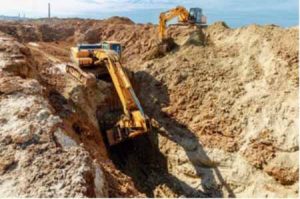 You can be trapped before there is time to react. So, it is very important that every excavation or trench be prepared correctly, allowing you to complete your job safely and efficiently.
You can be trapped before there is time to react. So, it is very important that every excavation or trench be prepared correctly, allowing you to complete your job safely and efficiently.
Remember every trench is different. Soil type, moisture content, depth, configuration, proximity to existing structures, and location of spoil piles all work together to make every excavation unique.
General Trenching and Excavation Rules:
- Keep heavy equipment away from trench edges.
- Identify other sources that might affect trench stability.
- Keep excavated soil (spoils) and other materials at least 2 feet from trench edges.
- Know where underground utilities are located before digging.
- Test for atmospheric hazards such as low oxygen, hazardous fumes, and toxic gases when greater than 4 feet deep.
- Inspect trenches at the start of each shift.
- Inspect trenches following a rainstorm or other water intrusion.
- Do not work under suspended or raised loads and materials.
- Ensure you have safe access and egress to all excavations, including ladders, steps, ramps, or other safe means of exit for working in trench or excavations 4 feet or deeper. These devices must be located within 25 feet of all workers.
- Inspect trenches after any occurrence that could have changed conditions in the trench.
- Ensure that personnel wear high visibility or other suitable clothing when exposed to vehicular traffic.
Remember you are the one going into the hole, so check the methods being used for protection. Prior to climbing down the ladder, check the spoil pile location and equipment that is near the excavation. Do you feel comfortable with the excavation, its protection, and the near surroundings?
SOIL IS HEAVY…PROTECT YOURSELF FROM TONS OF DIRT!
download flyer: STOTW_1150_Trenching Safety download Spanish flyer: STOTW_1150_Trenching Safety_esp

